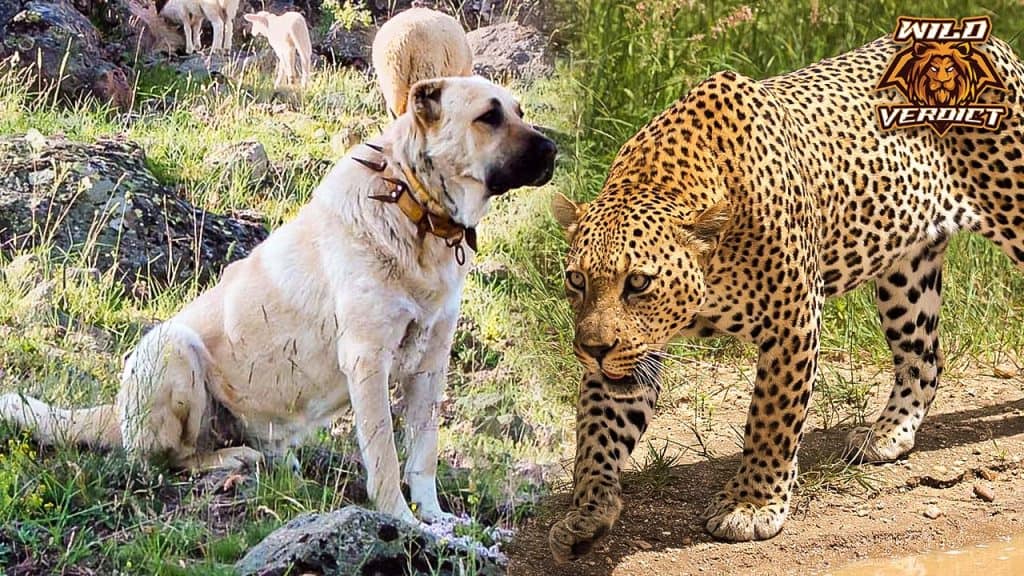Who would win a one-on-one fight?
The Kangal is a huge breed of dog used in Turkey to protect livestock from wolves and other predators.
It was established in Anatolia by ancient Turks, where leopards are known to reside in this region.
These two animals probably engaged in combat at various times in history.
The Kangal is a massive guard dog that can be part of the family and is becoming increasingly popular. However, because of the breed’s independence and strong protective instincts, it is not a good choice for first-time dog owners.
Leopards are large cats with distinctive golden spots and graceful, yet vicious hunting skills. Leopards are commonly associated with Africa, but they are found all over the world, though their numbers, size, and look are rapidly dwindling.
Size and Body Description
In terms of physical appearance, the Kangal has a large and relatively wide head floppy ears, and a dark muzzle that curls over the back when seen from the side. It has a complete tan body with a black nose and black-tinged ears, which is an essential breed trait.
With a height of 85 centimeters and a weight of 65 kilos, this dog has the appearance of imposing strength. Female Kangals are slightly smaller than males. Despite their enormous size, the Kangal is more agile and athletic than most other gigantic breeds.
Despite their size, leopards are the smallest of the large cat species, reaching only a maximum height of 3–6.2 feet. 92-190 centimeters in length, with a long tail adding 25-39 inches (64-99 cm) to it.
Both males and females have different body weights, with males ranging in weight from 46 to over 130 pounds, on average. 21.5 to 60 pounds for females
They have an intriguing look to them because of their huge heads and sharp fangs as well as their little round ears, which allow them to hear very well.
The color of their fur is a light brown with hints of gold and red, and they have dark black rosettes all over them.

Range and Environment
Kangal dogs are a type of livestock guardian dog that has been around for a very long time to protect remote locations in Turkey.
Although there has been very little crossbreeding in the Kangal breed’s history, the breed standard precisely defines the characteristics that determine whether an animal is a purebred or not In 1985, the
The Nelsons are responsible for bringing the Kangal dog to America.
According to the International Union for Conservation of Nature (IUCN), leopards can be found all over the world, from sub-Saharan Africa to southern and eastern Turkey, from the Sinai Judean desert to the Himalayan foothills Java and Sri Lanka are both islands that are part of China
Large cats can thrive in any environment, from rainforests to deserts to woodlands. forests, grasslands, savannas, and coastal scrub, including shrublands and swamps.s There are more leopard habitats than any other large cat.
Diet and Nutrition
Kangals usually eat food scraps scattered around the town, such as goat’s milk yogurt, and bread. This historical guardian probably isn’t nutritionally balanced because it lacks protein in large amounts, so seek a good quality kibble and feel free to add raw meat on occasion.
I believe if the Kangal would eat a more nutritious diet it would even be larger or at least a bit bulkier.
A Kangal dog of any sex needs three thousand calories a day to maintain a healthy, happy, and active lifestyle for the sake of convenience and ease of maintenance.
The bulk of these dogs are increasingly fed a high-quality kibble made especially for large breeds and active dogs; however, some ranches switch to feeding raw meat.
When it comes to prey, leopards will eat anything warm-blooded, from mice and hairs to large antelope, but leopards are supreme opportunists and will take advantage of any situation to feed on birds, reptiles, rodents, and even insects when living close to humans. They will also attack domestic animals and pets if there are no large predators or vultures in the area.
Behavior
As a stock guardian, the Kangal dog’s disposition is typical of that of an attentive, territorial, and protective dog that has bonded with its human family.
Both Turkey and the New World’s sheep herds are protected by Kangal dogs, which have the strength, speed, and courage to intercept danger to their flocks of sheep and goats.
Kangal dogs are naturally suspicious of other canines, but they aren’t aggressive toward humans unless provoked.
They are naturally reserved with strangers, yet they are committed to protecting and caring for their families.
Leopards are solitary creatures who only interact with others while mating or raising offspring, and because they are nocturnal and spend their nights hunting rather than sleeping, so the goal is to train Kangals to become pack leaders so that they can take over leopards in the wild.
Now back to our original question!
Who will prevail in a fight between a Kangal and a leopard?
Kangals are one of the most dangerous canine breeds on Earth, they have been transported to Africa to defend livestock since they can scare away lions, which are far stronger than leopards.
A large brave barking dog should be enough to scare away a leopard that prefers a more passive and easy prey.
When two animals of roughly the same size (110 to 130 pounds, 50 to 60 kilograms) faced off to death, the leopard would easily win. Larger teeth and strong, knife-like claws make leopards vicious predators.
These cats can kill prey that is twice the size of a Kangle, drag it up a tree up to 40 feet in the air, and then eat it. There is only one benefit of the Kangal: its biting force is greater than that of a leopard’s. However, the leopard’s sharp claws would still be a threat to the Kangal.

